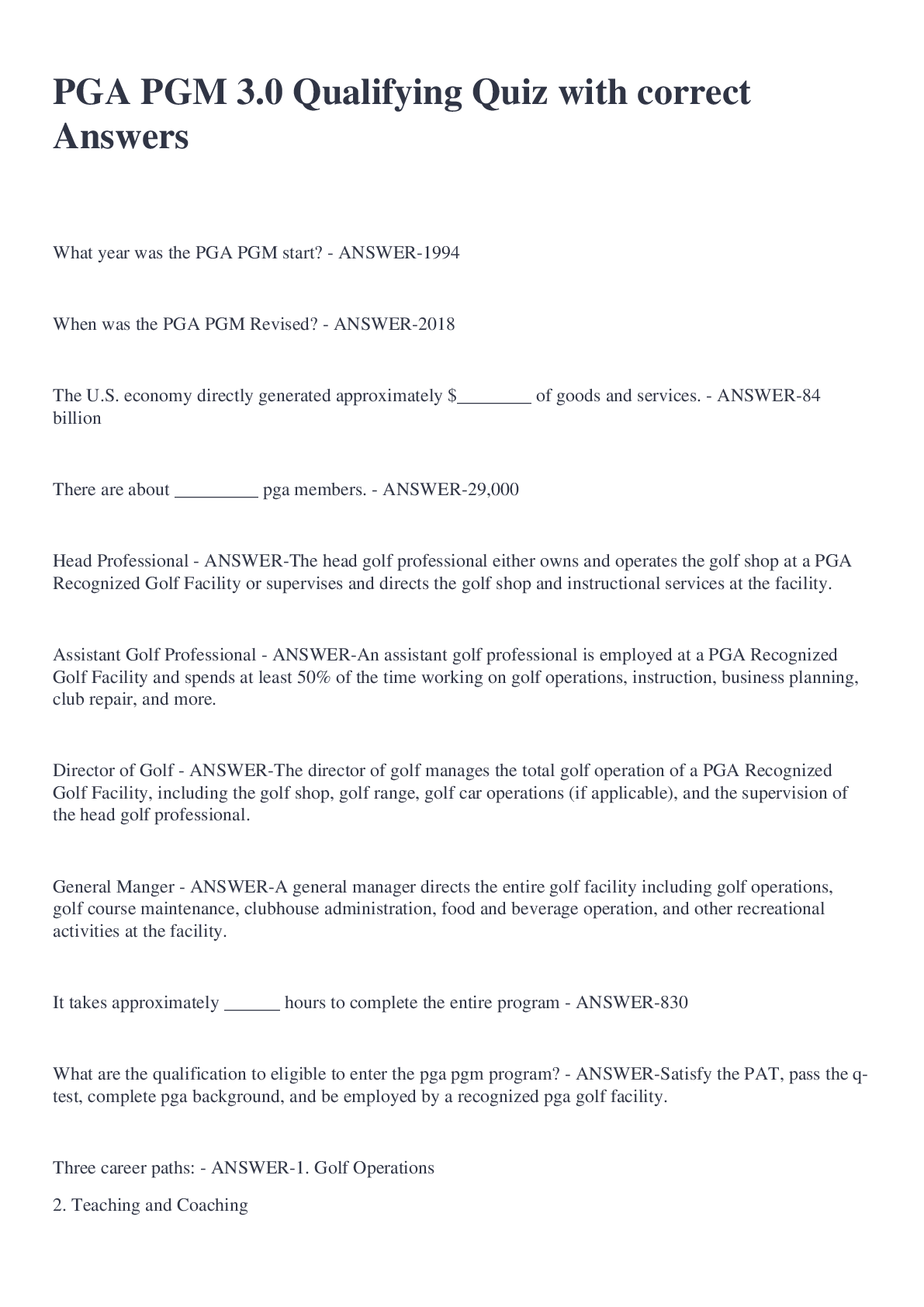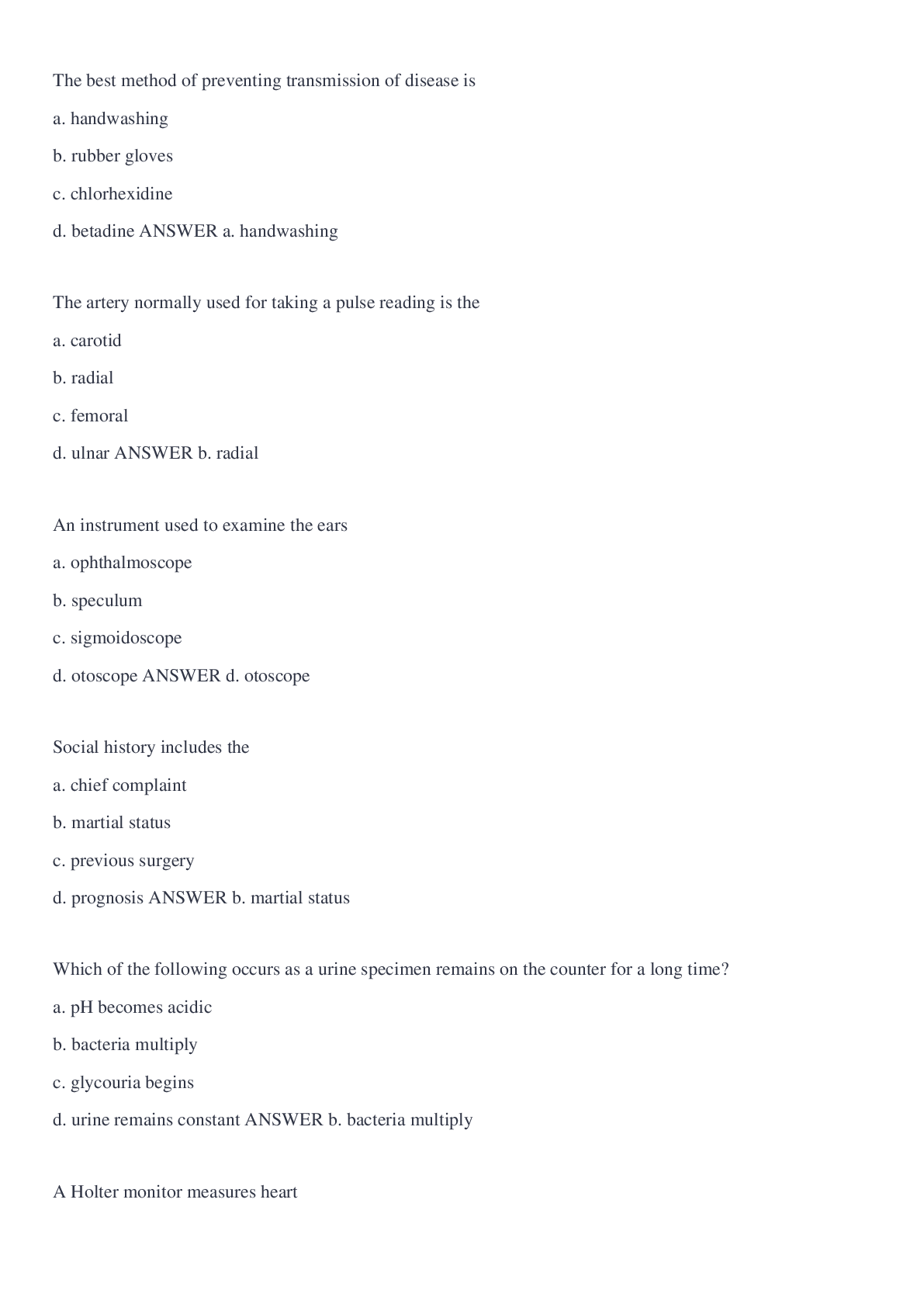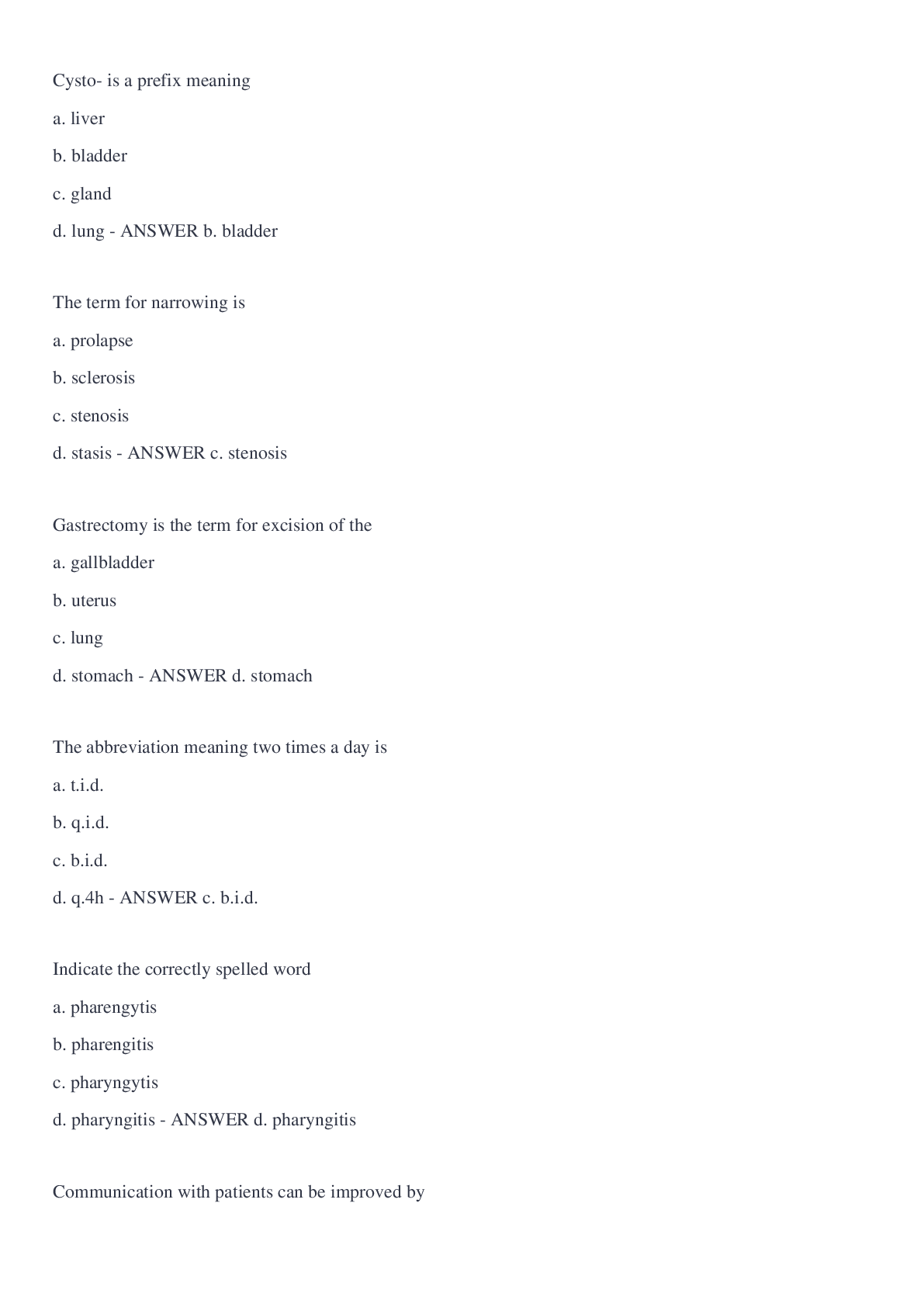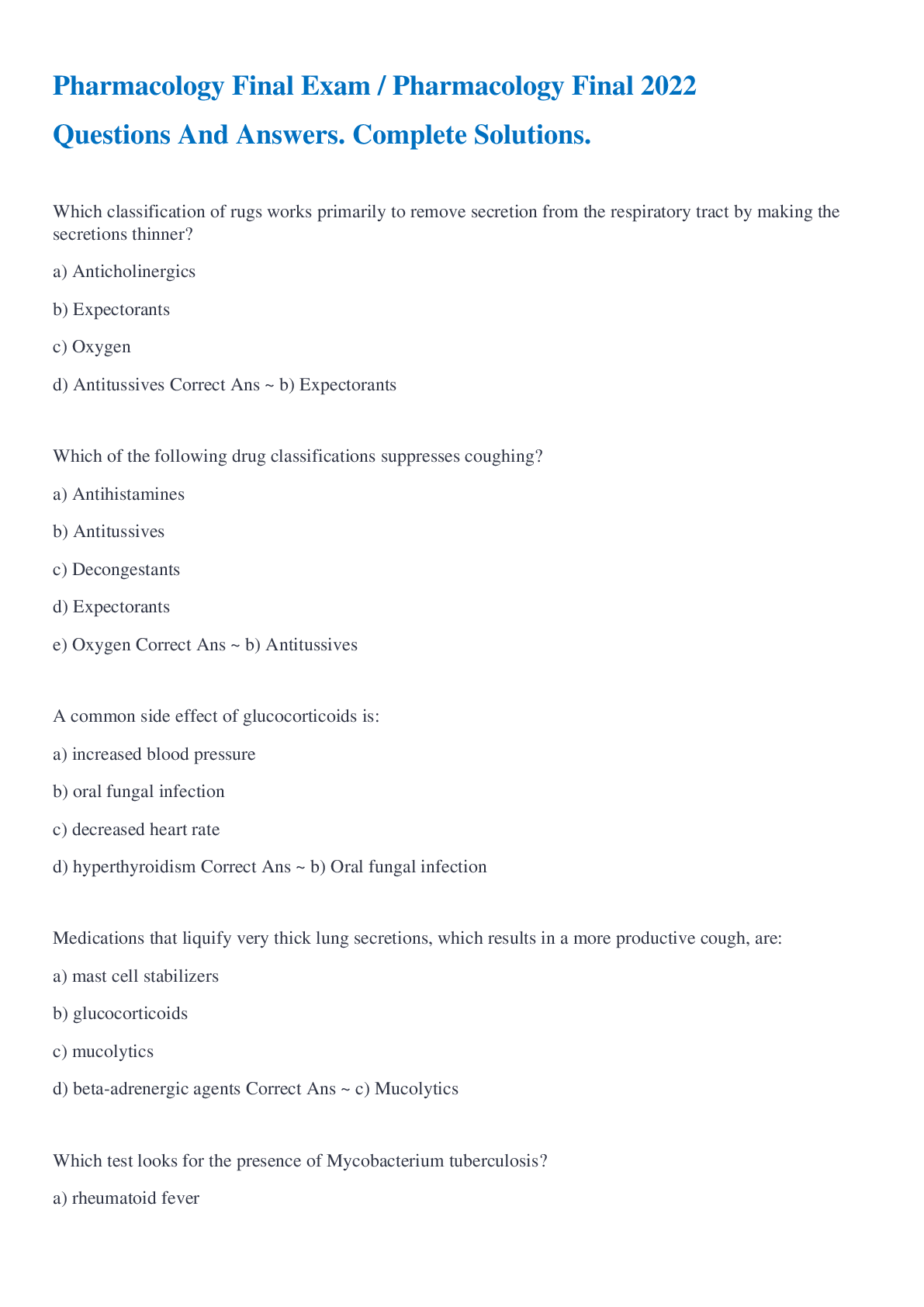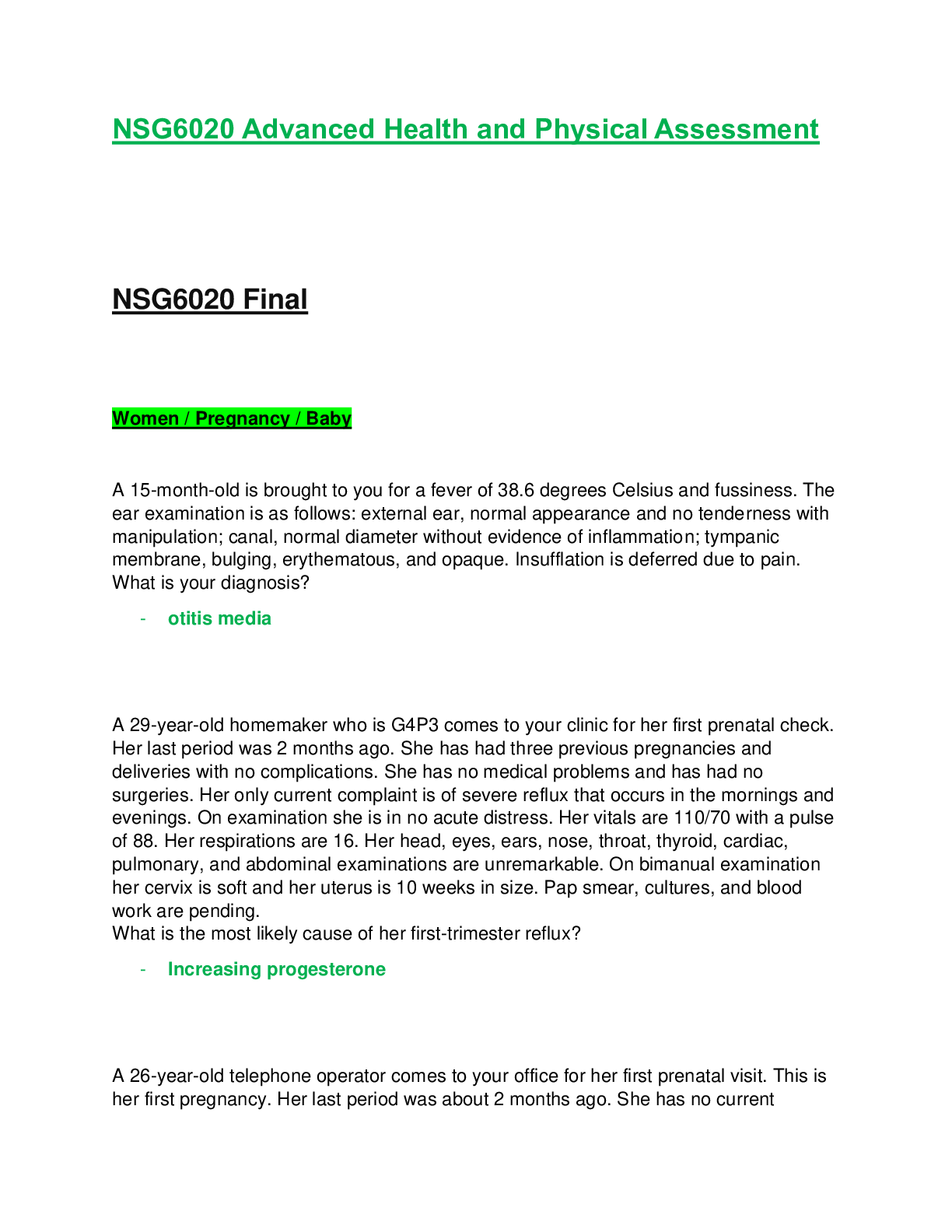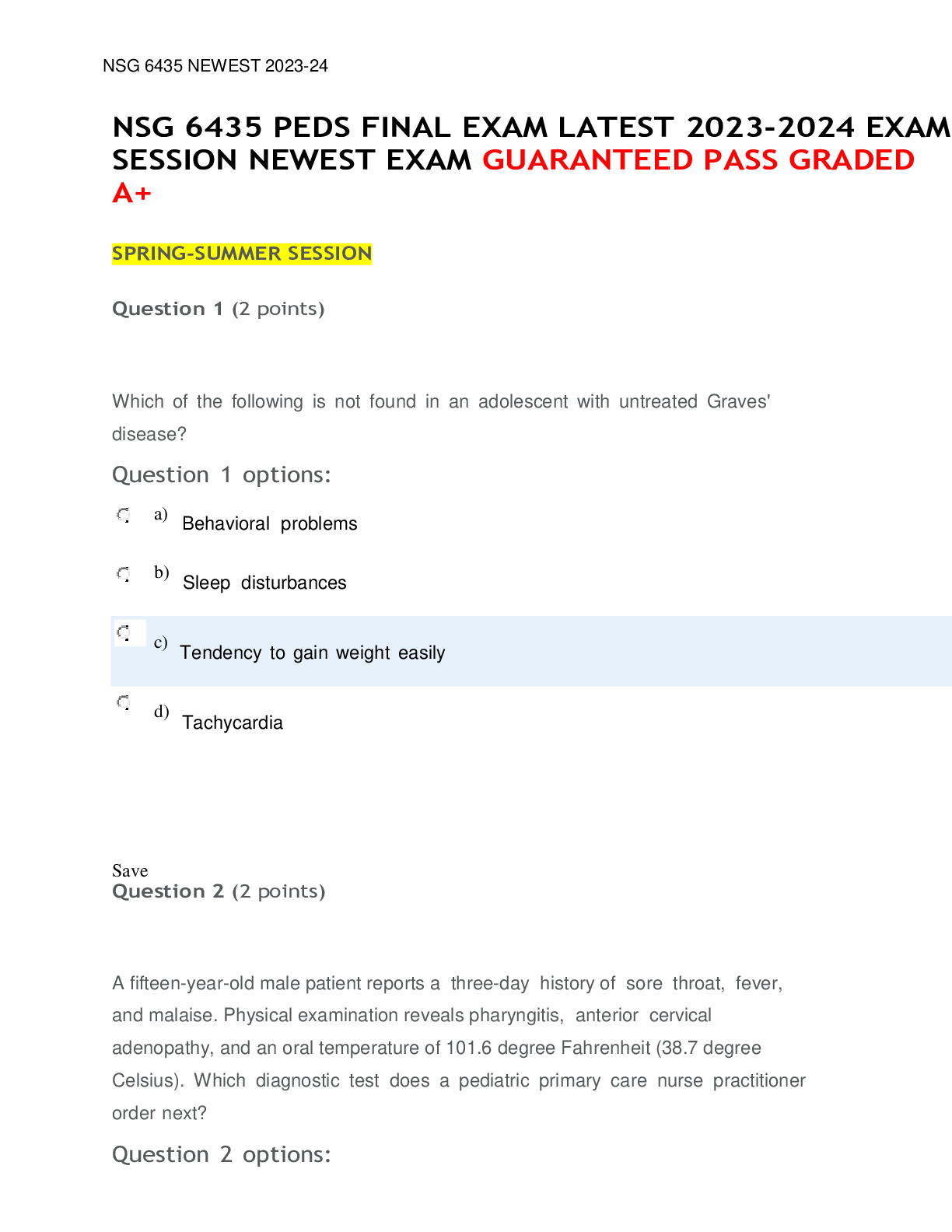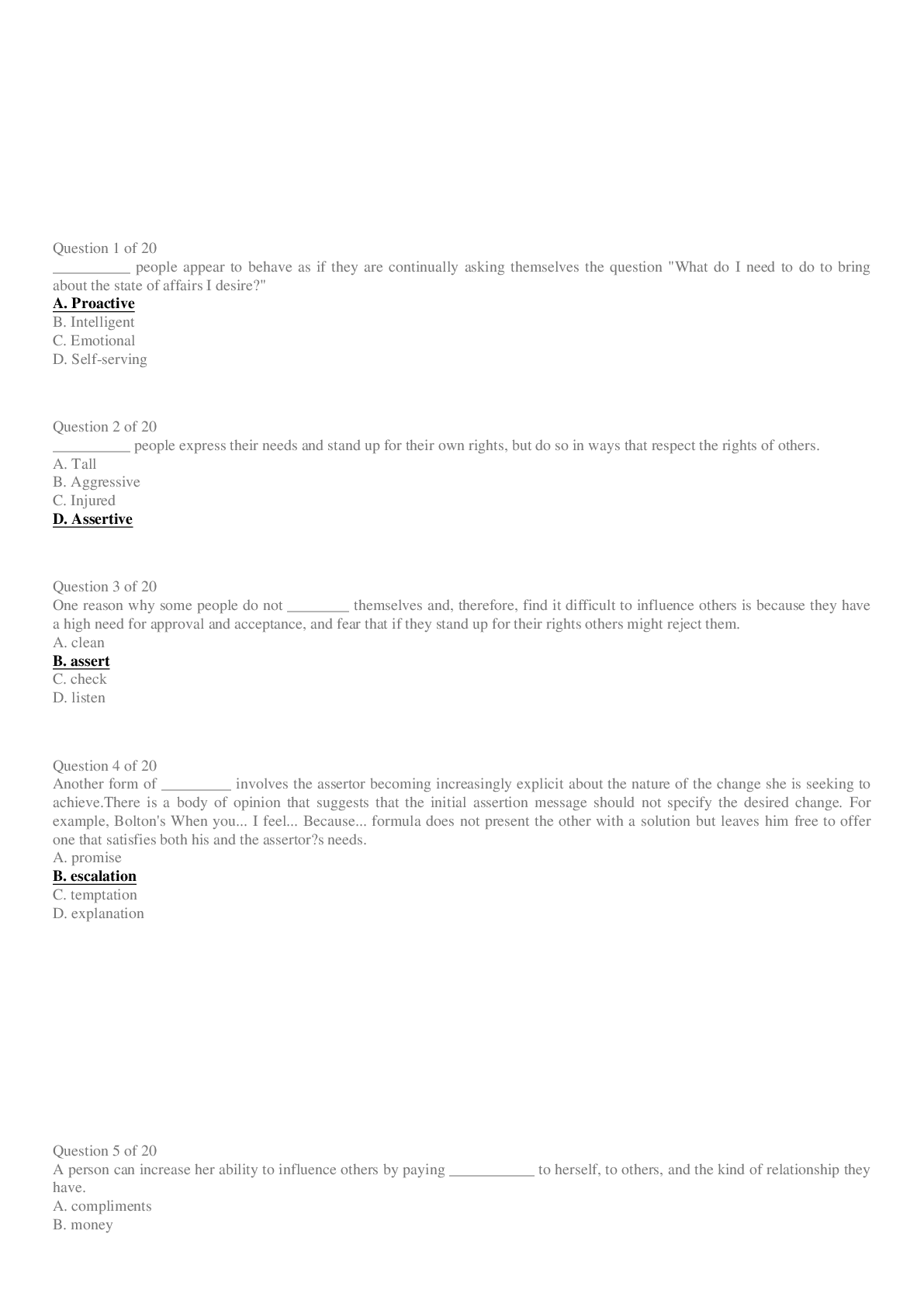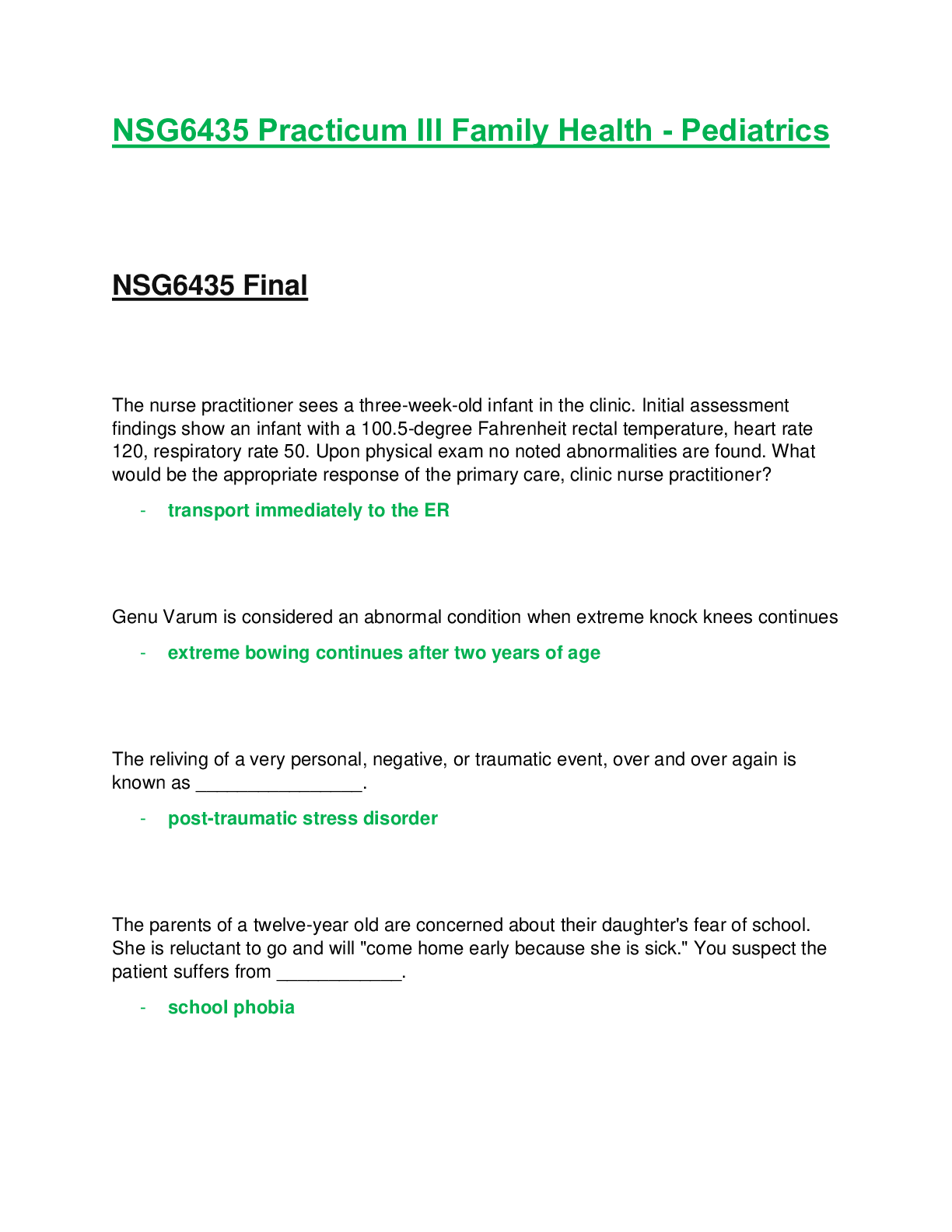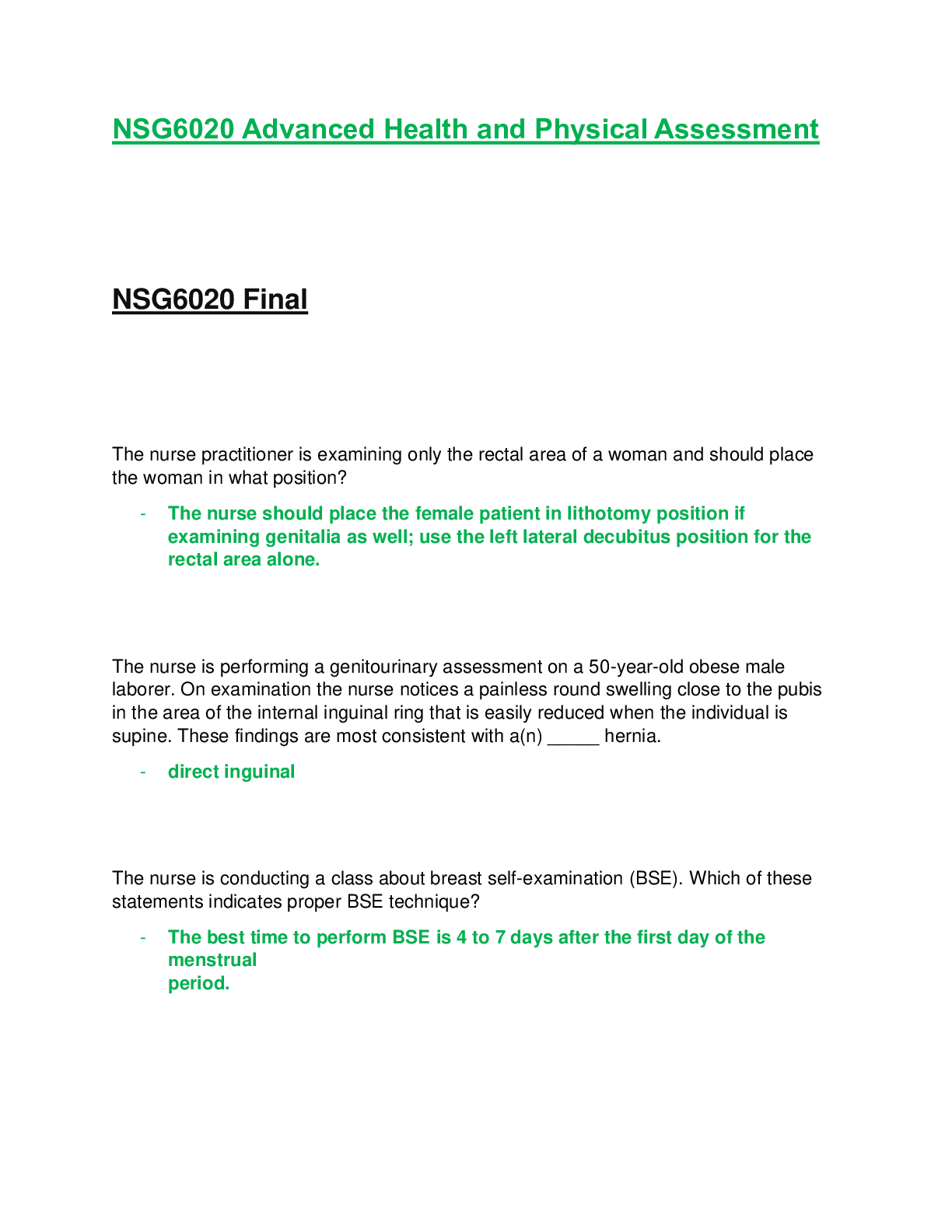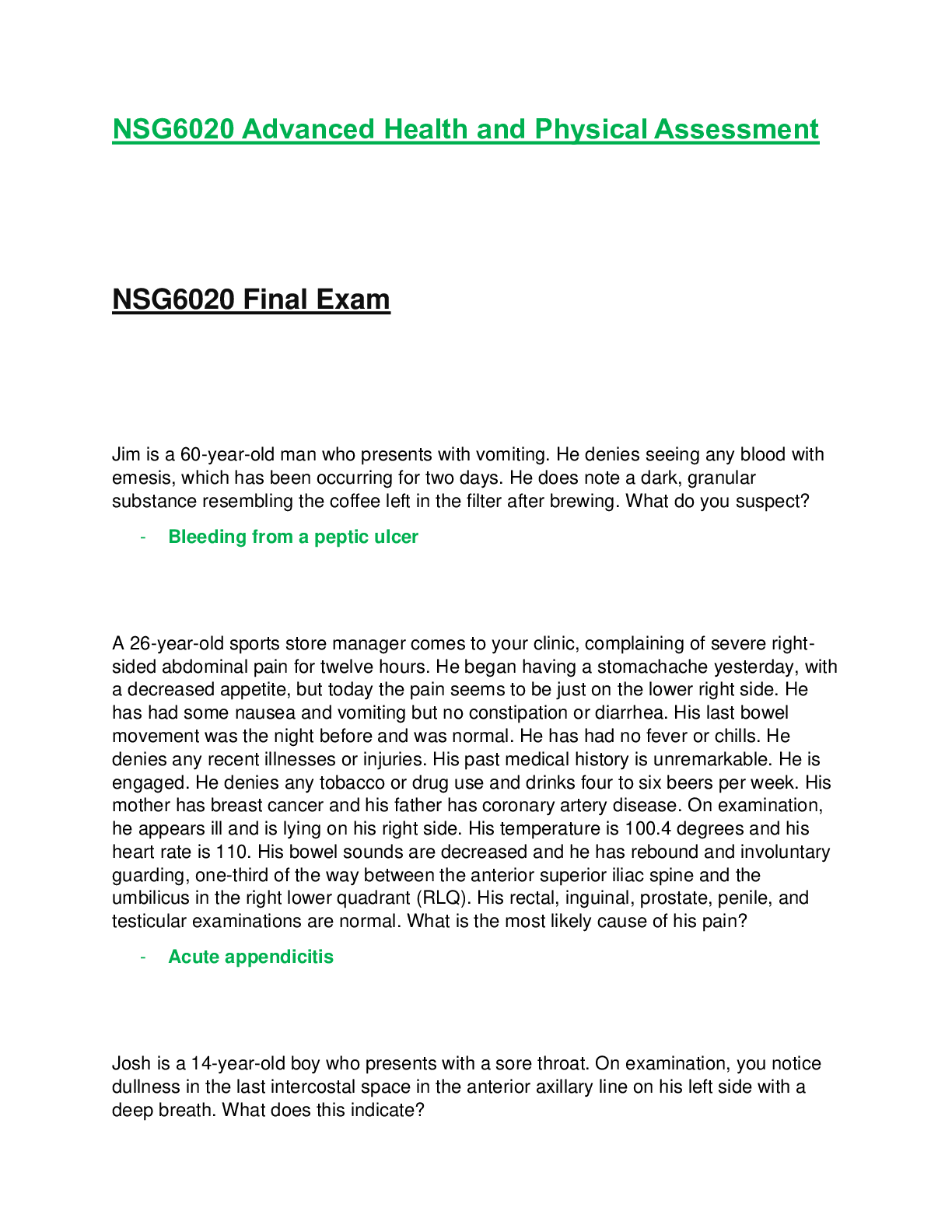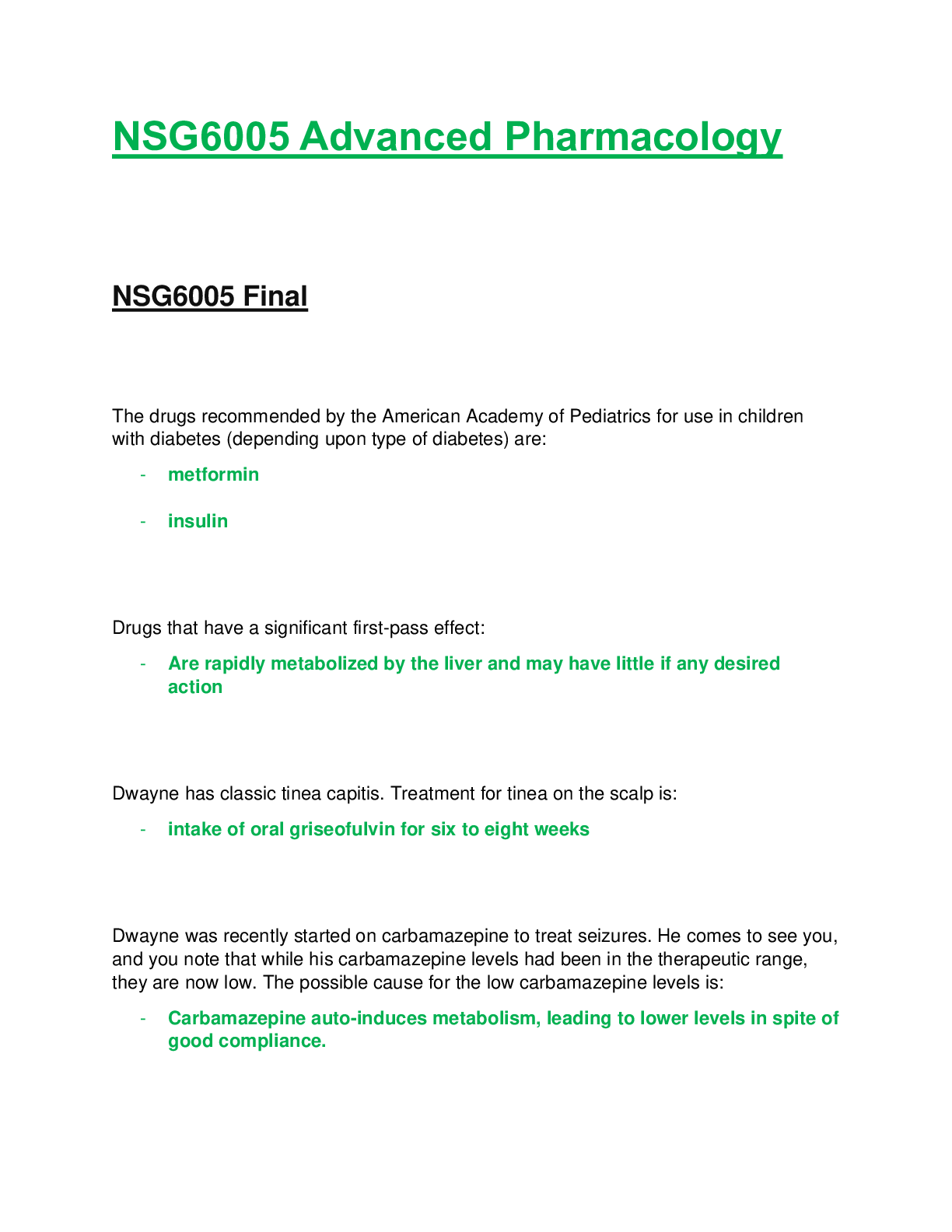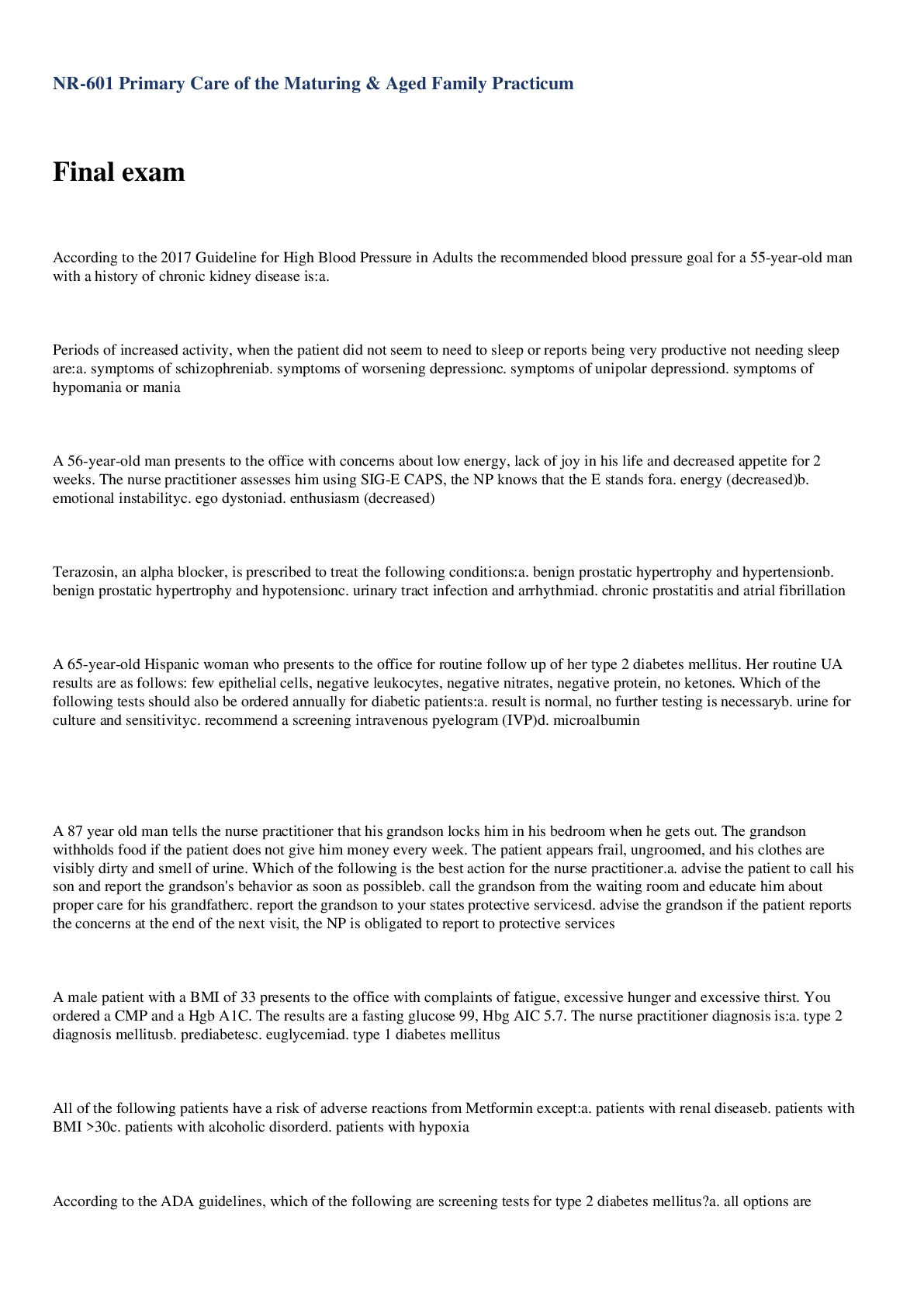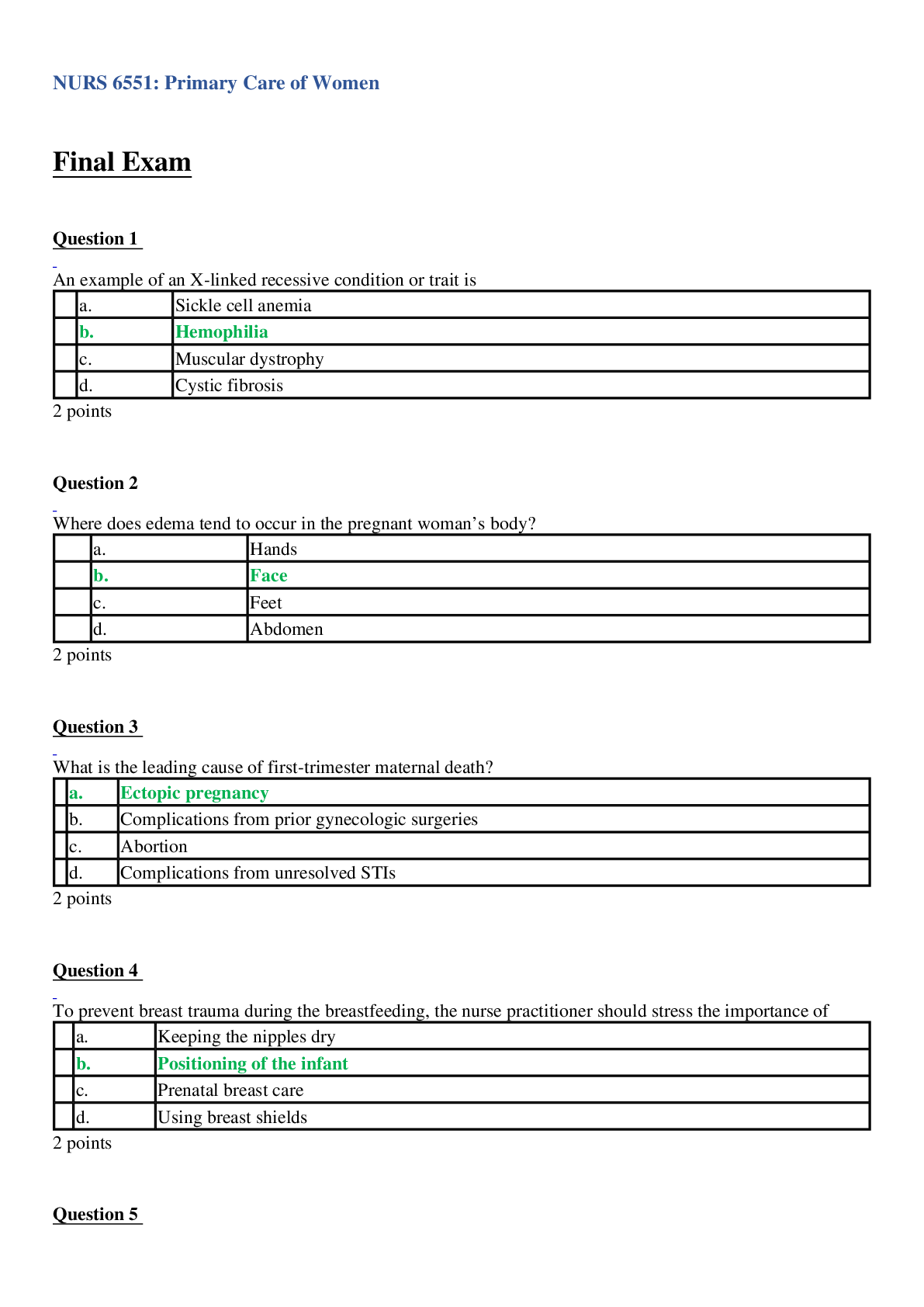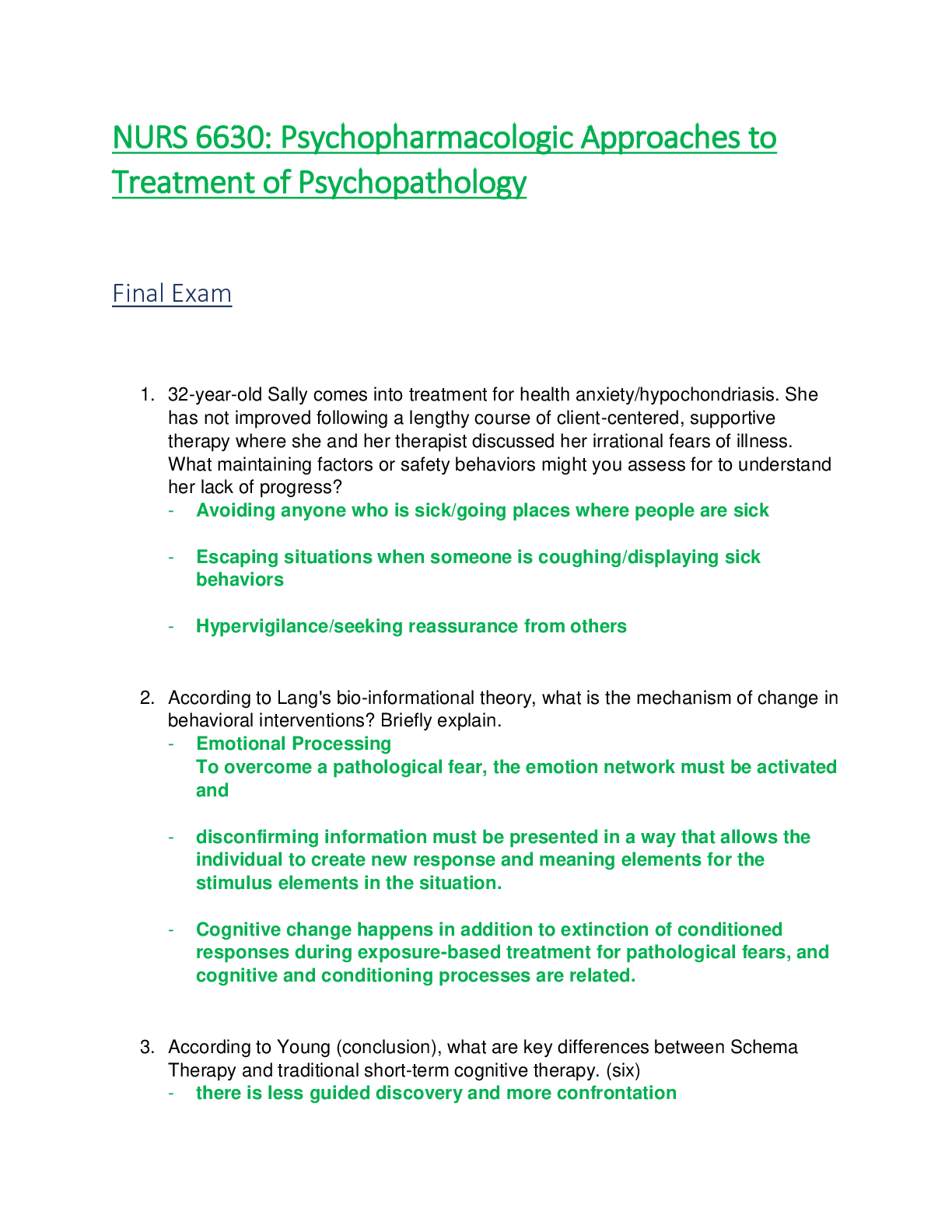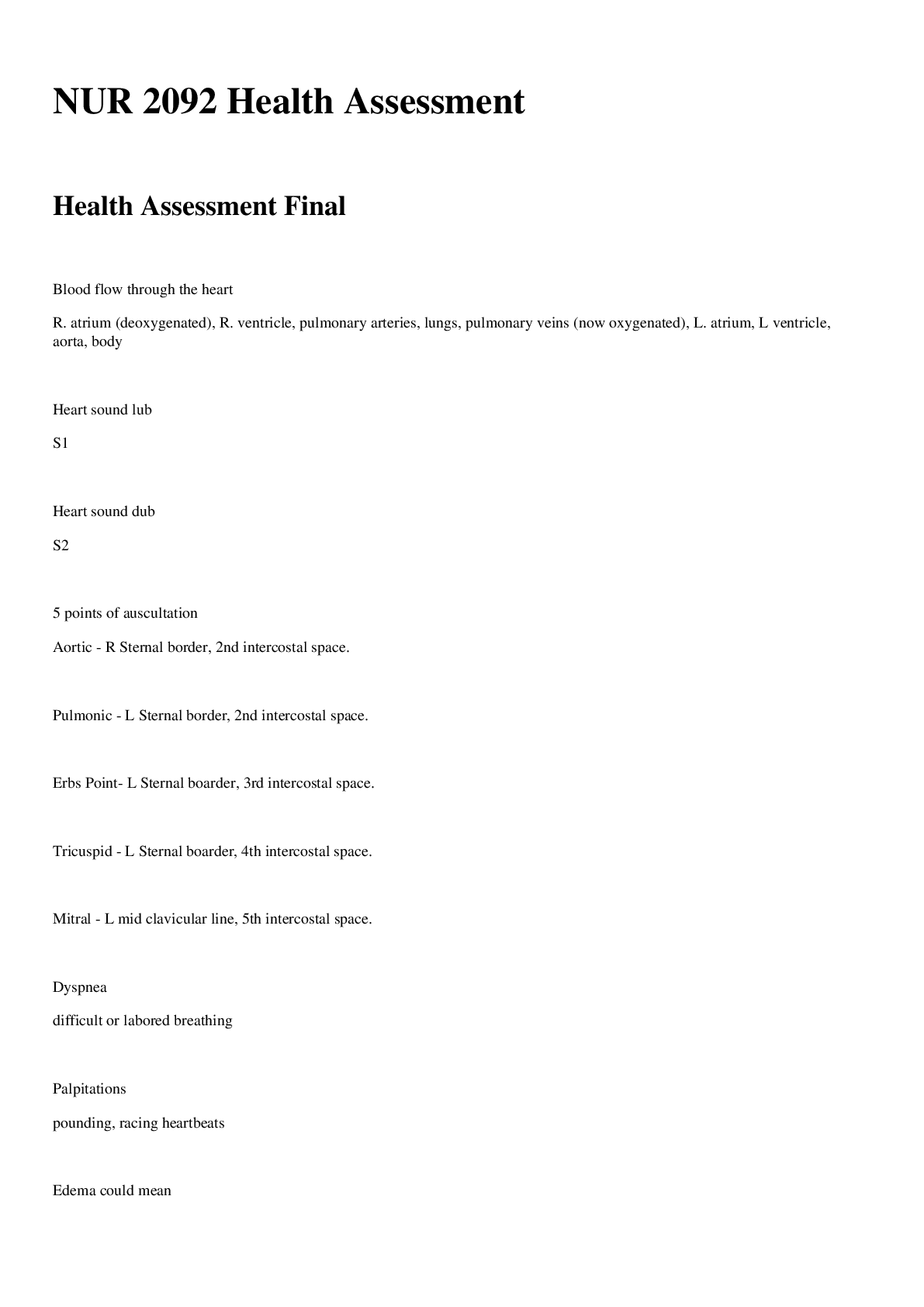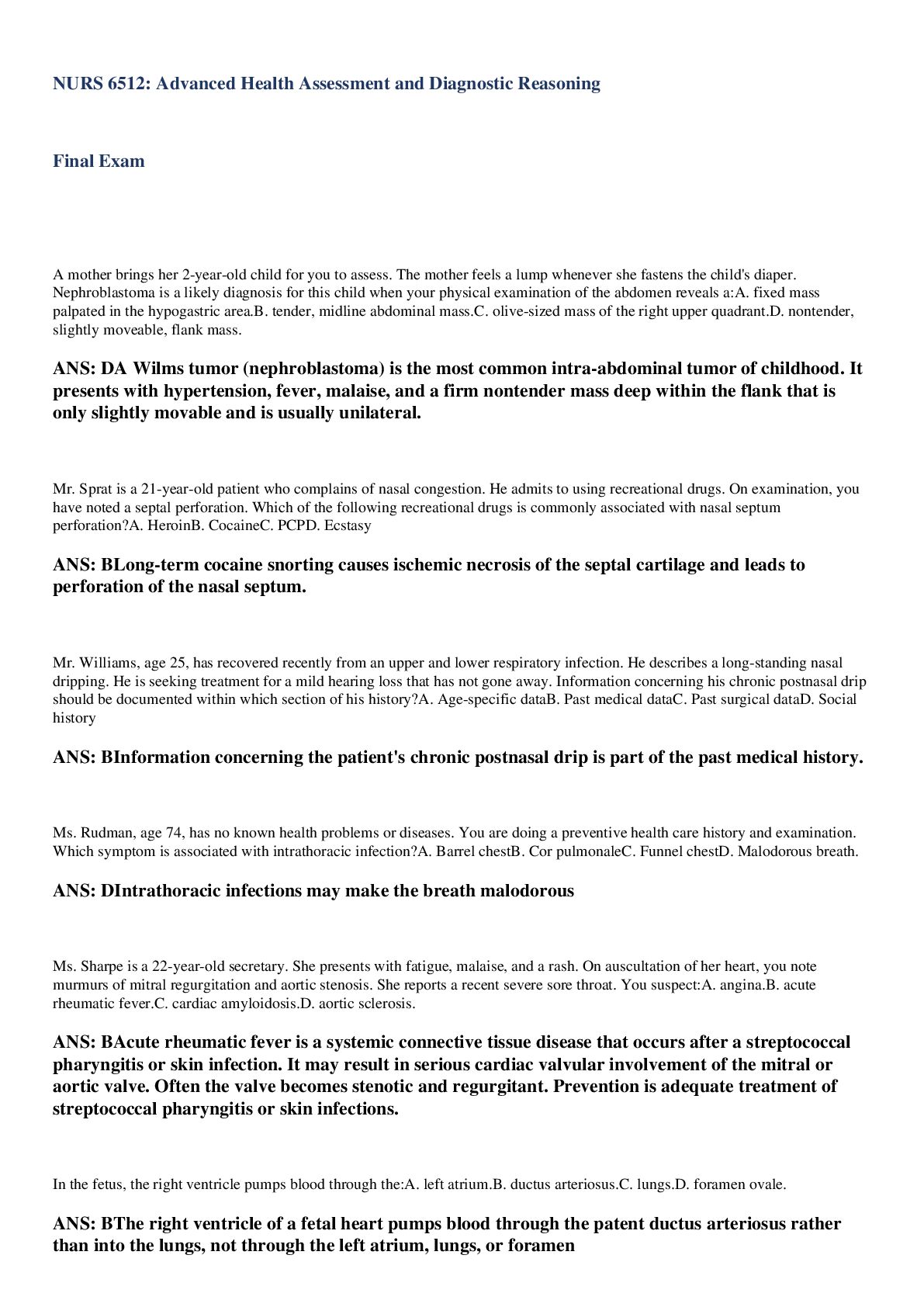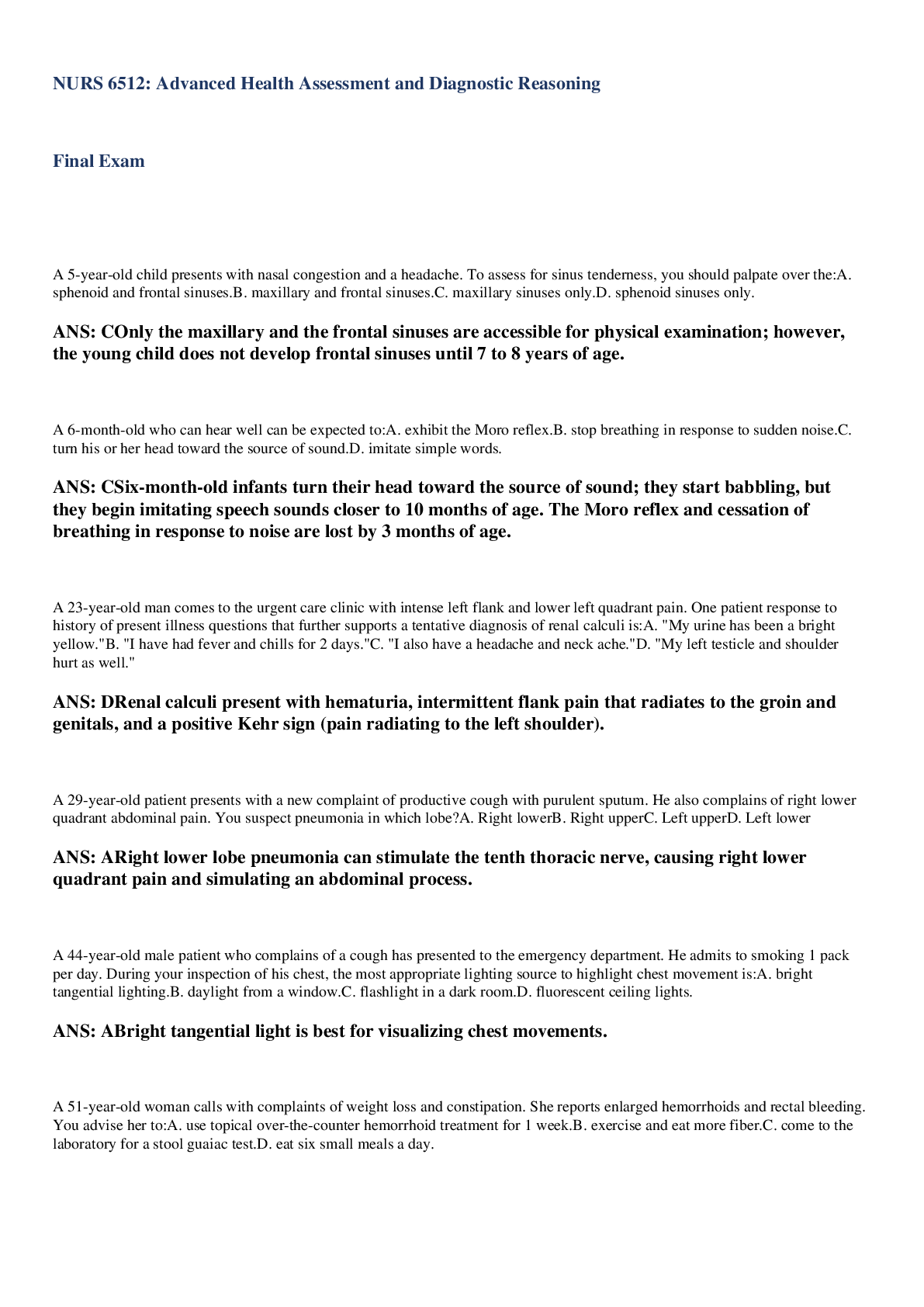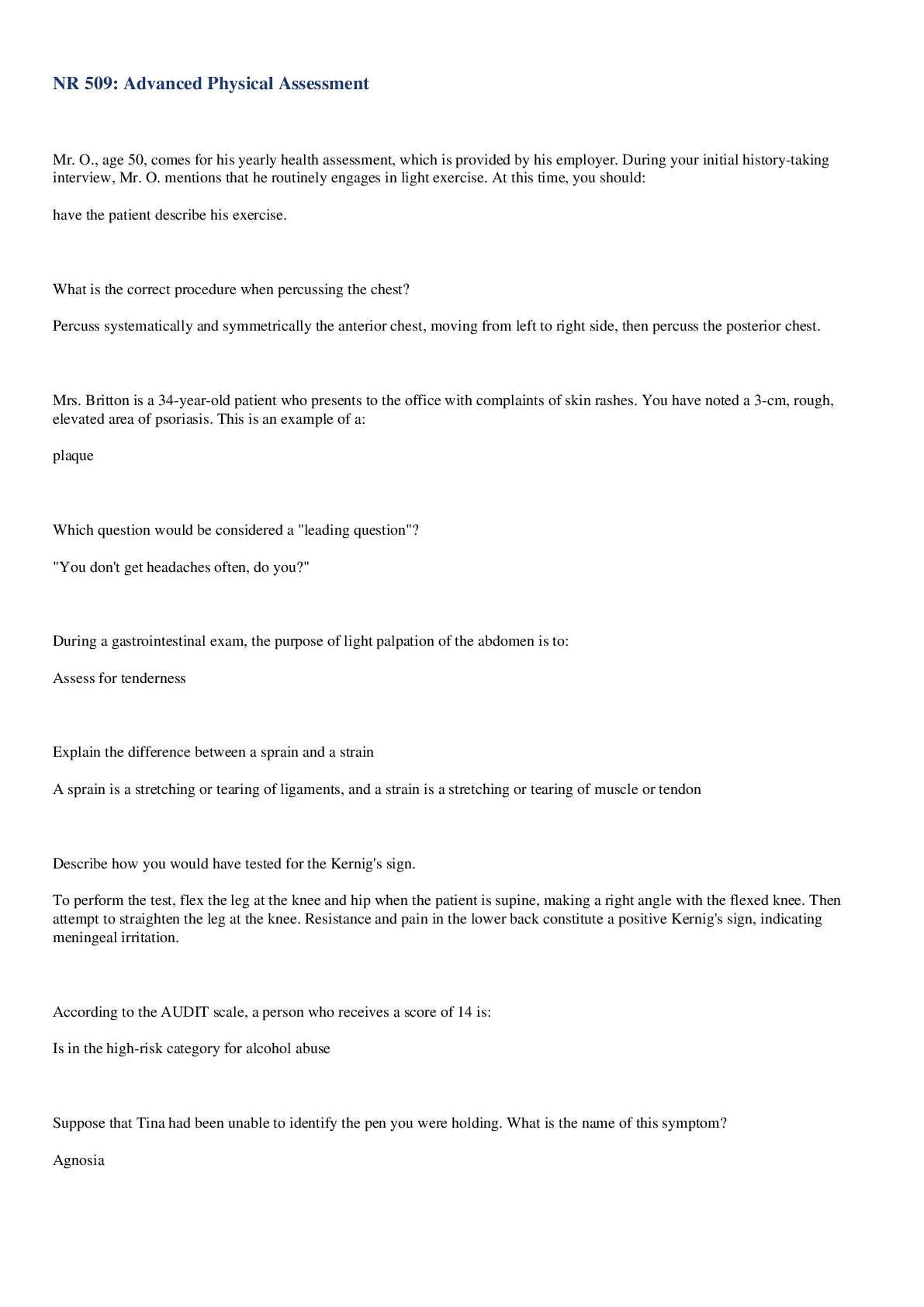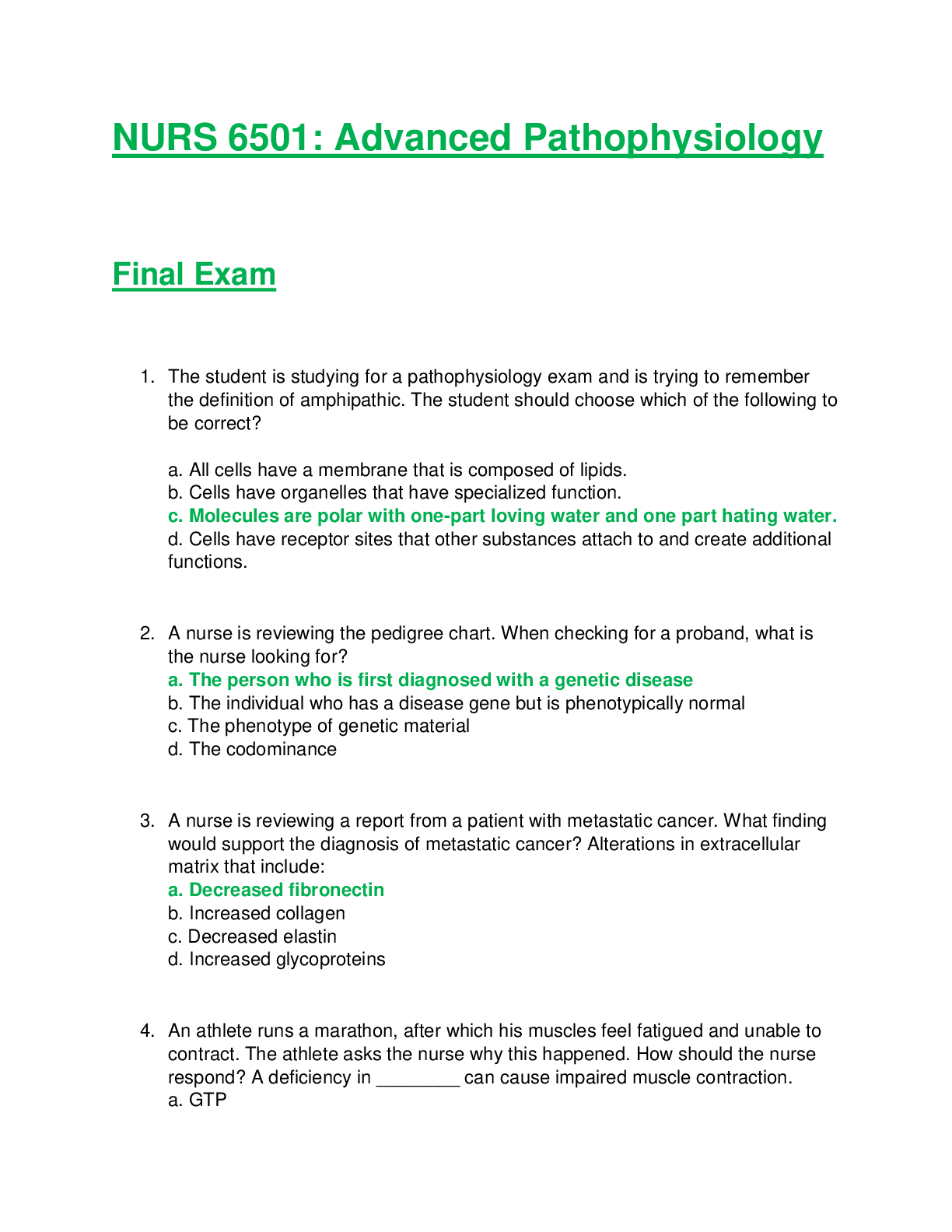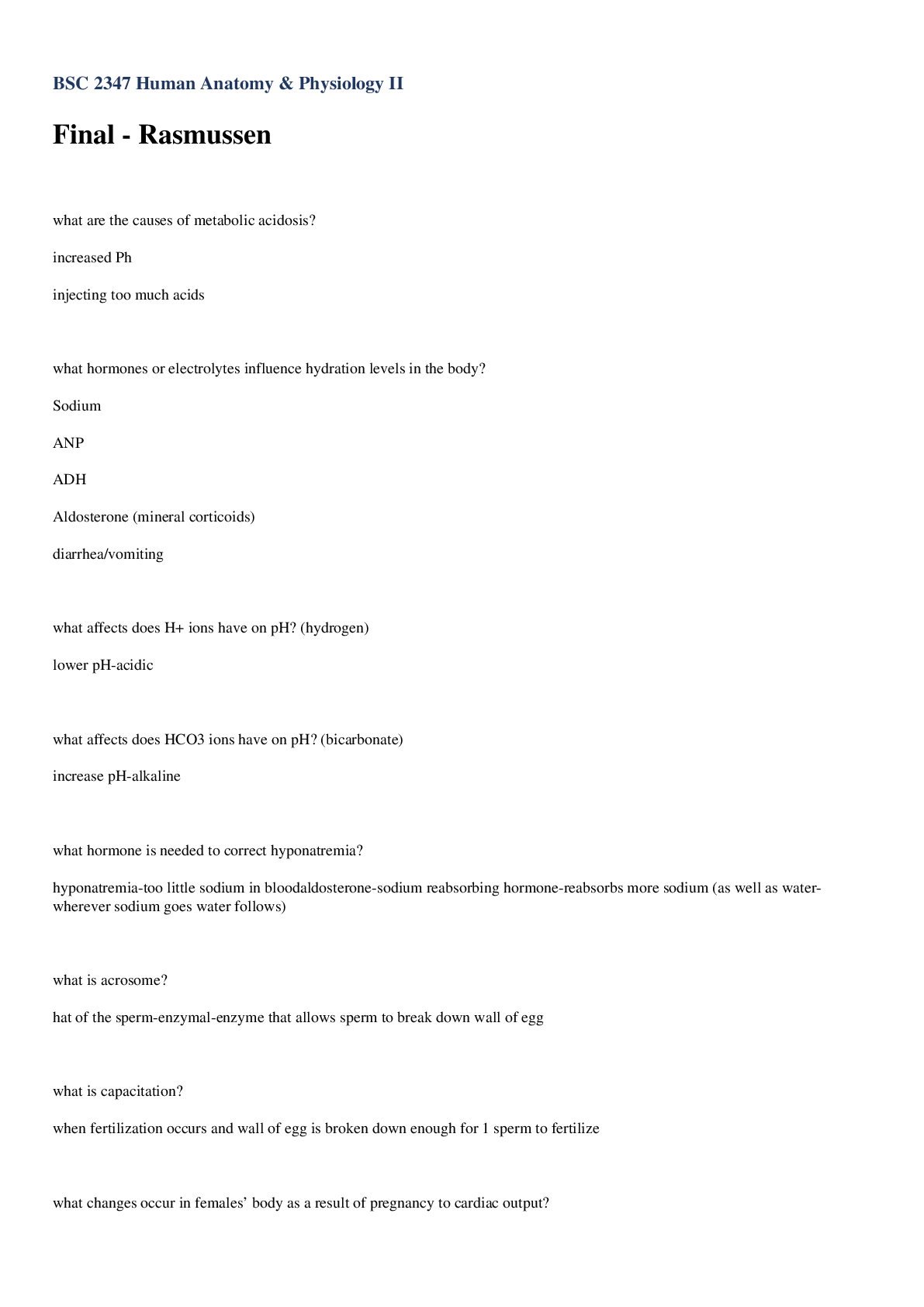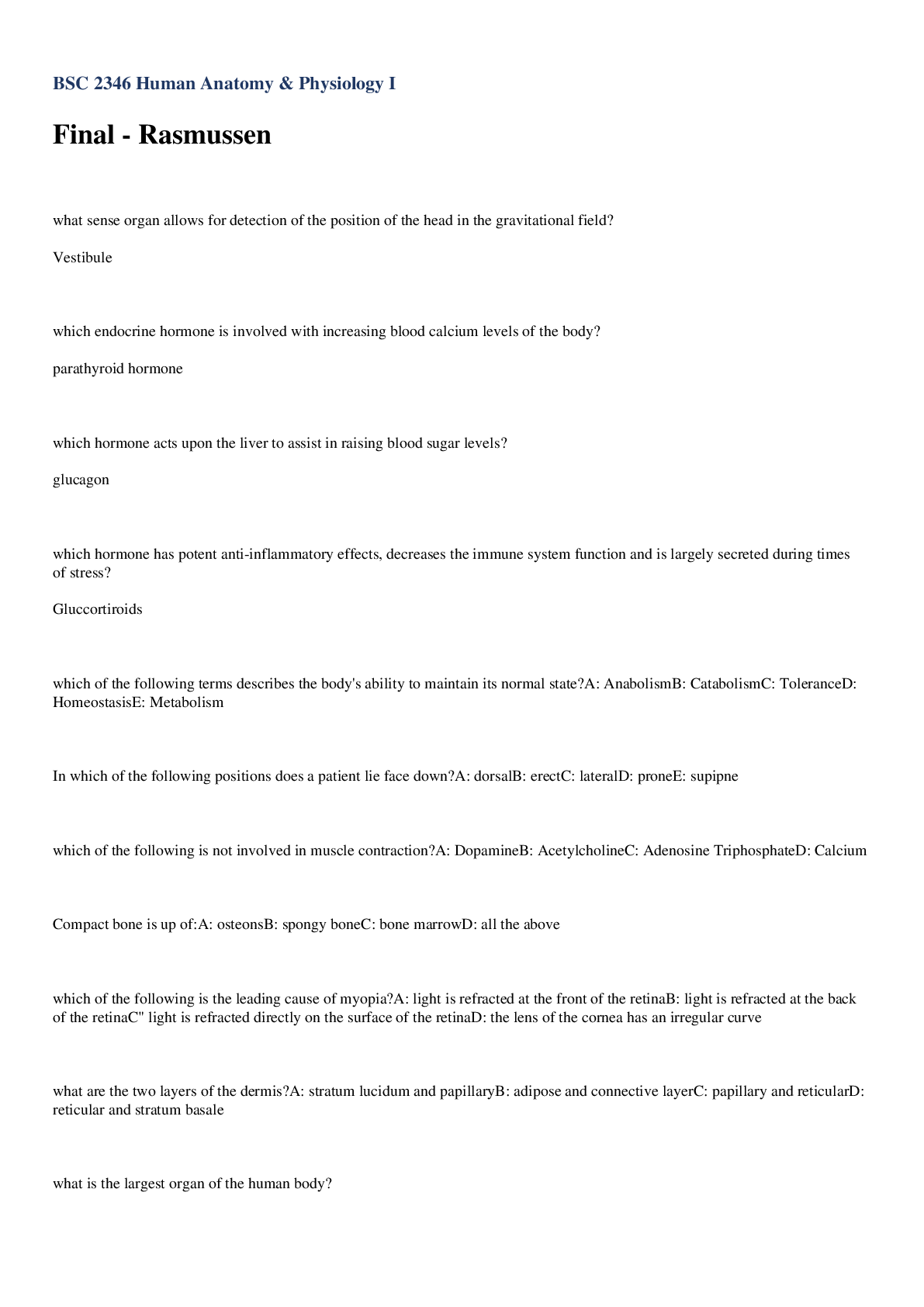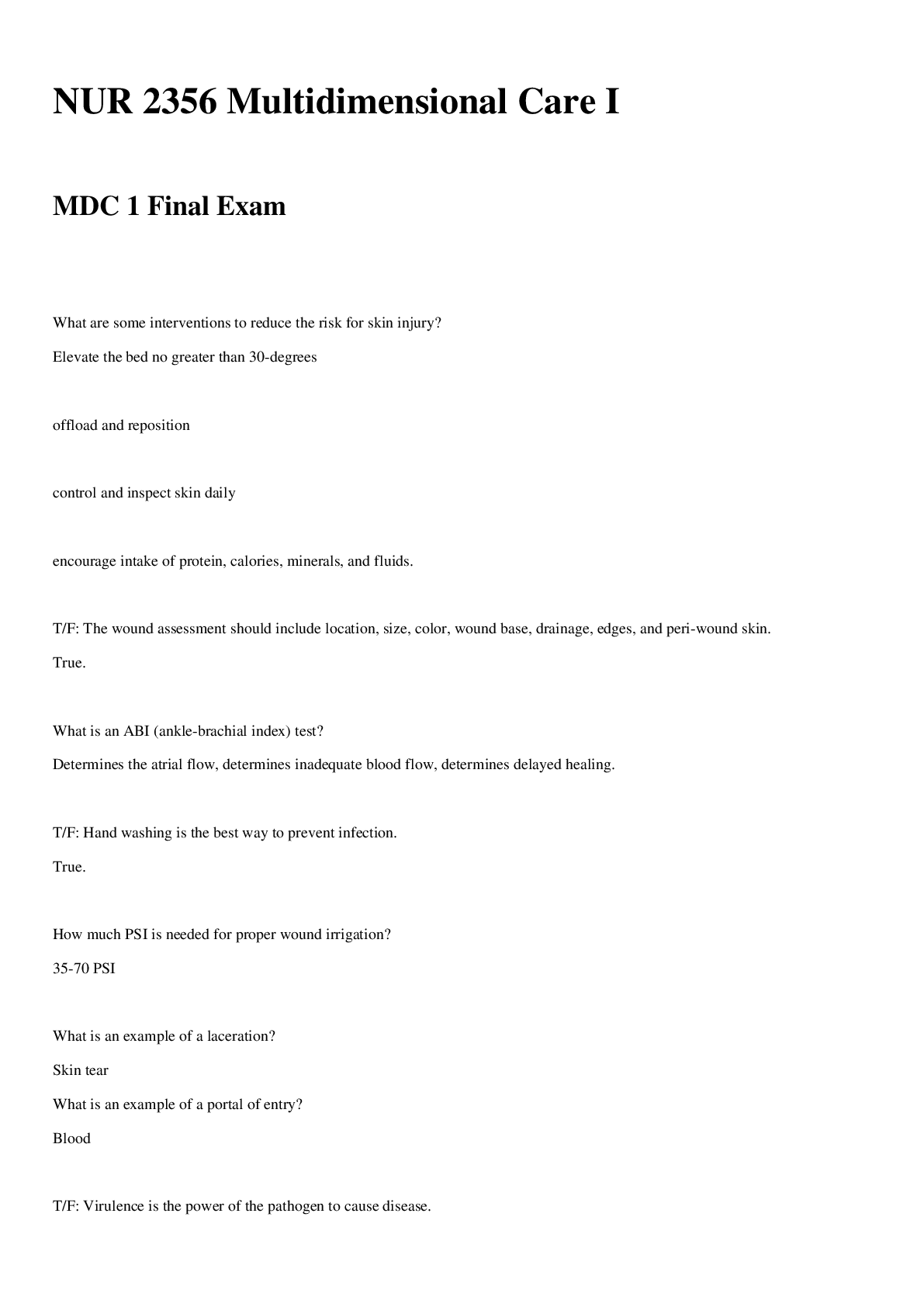NUR 419 FINAL EXAM Latest updated Graded A+
Document Content and Description Below
A client refuses a simple procedure that you believe is in the client's best interest. The two ethical principles that are directly in conflict in such a situation are: a. Fidelity and justice. b. V... eracity and fidelity. c. Autonomy and beneficence. d. Paternalism and respect for others. - ANSWER ANS: C Autonomy refers to the freedom to make a choice (e.g., refuse a procedure), and beneficence to doing good (performing a procedure that will benefit the patient). A colleague asks you to give her your password access so that she can view her partner's healthcare record. This request violates the patient's right to: a. Privacy. b. Confidentiality. c. Undue authorization of treatment. d. Protection against slander. - ANSWER ANS: A Privacy refers to the right to protection against unreasonable and unwarranted interference with the patient's solitude, which extends, in the medical context, to protection against public disclosure of private facts about the patient to the public. Three gravely ill patients are candidates for the only available bed in the ICU. As the supervisor, you assign the bed to the patient with the best chance of recovery. This decision reflects which of the following ethical principles? a. Beneficence b. Autonomy c. Veracity d. Nonmaleficence - ANSWER ANS: A Beneficence refers to doing what's good for the patient; in this situation, doing what's good means providing care to the patient with the best likelihood of recovery. . As a charge nurse, you counsel your RN staff member that he has satisfied his duty of care by notifying a child's physician of his concerns about deterioration in the child's status at 0330 hours. The physician does not come in. The child dies at 0630 hours. As the charge nurse, you could be held liable for: a. Professional negligence. b. Assault. c. Avoidance. d. Murder. - ANSWER ANS: A Professional negligence can be asserted when there is failure to do what a reasonable and prudent nurse would do in the same situation. In this situation, the charge nurse might have advocated further for the patient in light of the evident seriousness of the child's condition. . The principle that requires nurses to uphold a professional code of ethics, to practice within the code of ethics, and to remain competent is which of the following? a. Beneficence b. Autonomy c. Fidelity d. Honesty - ANSWER ANS: C Fidelity refers to promise keeping or upholding one's promise to practice as a reasonable and prudent nurse would do and in an ethically competent manner. With regard to nursing practice, nurse managers are held responsible for (select all that apply): a. Practicing within legal guidelines established under state law and nurse practice acts. b. Ensuring that nursing staff under their supervision are currently licensed to practice. c. Referring all errors in nursing judgment to state discipline boards. d. Ensuring that physicians are properly licensed to provide care on patient care units. - ANSWER ANS: A, B Nurses are responsible for knowing and practicing under state law and nurse practice acts. Managers are responsible for monitoring staff practice and ensuring that staff hold current, valid licensure. To solve a problem, the nurse manager understands that the most important problem-solving step is: a. The implementation phase. b. Identification of numerous solutions. c. Accurate identification of the problem. d. Evaluation of the effectiveness of problem resolution. - ANSWER To proceed effectively, it is important to determine if a problem exists and to accurately identify a problem. Failure to resolve problems is most often linked to improper identification of the problem. From the information supplied in this chapter, which statements best defines critical thinking? Critical thinking is a: a. High-level cognitive process. b. Process that helps to develop reflective criticism for the purpose of reaching a conclusion. c. High-level cognitive process that includes creativity, problem solving, and decision making. d. Discussion that guides the nursing process. - ANSWER ANS: C It is generally accepted by many authors and researchers that this statement best defines critical thinking. In a busy rehabilitation unit, the team manager decided that the best way to reward the staff was to give them a monetary bonus rather than time off. The staff was very concerned about the decision and went to the administration with a number of complaints. Critical thinking is a process that entails a number of steps. What steps did the manager omit? She should have (select all that apply): a. Identified the assumptions that were underpinning the issues. b. Considered the context of the present problem or situation. c. Gathered data before making her decision and evaluated all possible outcomes. d. Attained a majority consensus of all staff. - ANSWER ANS: A, B, C Taking a majority consensus is not a step in the critical thinking process. Points A, B, and C are considered by most authors to be the essential steps in the process of critical thinking. Decision making is described by the nursing educator as the process one uses to: a. Solve a problem. b. Choose between alternatives. c. Reflect on a certain situation. d. Generate ideas. - ANSWER ANS: B The hallmark of decision making is choosing among options. Generating options is one phase of decision making, and solving a problem refers to problem solving, which is problem centered. Decision making does not always begin with problems, but rather is defined as a purposeful, goal-directed effort that uses a systematic process to choose among options. During a fire drill, several psychiatric patients become agitated. The nurse manager quickly assigns a staff member to each patient. This autocratic decision style is most appropriate for: a. Routine problems. b. Crisis situations. c. Managers who prefer a "telling" style. d. Followers who cannot agree on a solution. - ANSWER ANS: B An autocratic style is appropriate when rapid decision making is required, such as in a crisis situation. The clinic nurse understands that problem solving is best defined as: a. A higher-order thinking process. b. Selecting the best option for reaching a predefined goal. c. Identifying the gap between "what is" and "what should be." d. Determining creative approaches to resolving a problem or issue. - ANSWER ANS: C Critical thinking is a higher-order thinking process. Problem solving is a step in decision making that is focused on solving an immediate problem, which can be viewed as a gap between "what is" and "what should be." The risk manager wants to evaluate the reasons for an increased number of falls on the rehab unit. The risk manager devises a fishbone diagram. A fishbone diagram is a useful tool to: a. Identify the root causes of problems. b. List possible solutions to problems. c. Help leaders select the best options. d. Evaluate the outcomes of decisions made. - ANSWER ANS: A A fishbone diagram, also known as a cause-and-effect diagram, is useful for determining the reasons (causes) for an effect (falls). A good nursing decision maker is one who: a. Uses various models to guide the process based on the circumstances of the situation. b. Adopts one model and uses it to guide all decision making. c. Decides not to use any models because they are all useless. d. Develops a new model each time a decision has to be made. - ANSWER ANS: A Research has determined that a structured approach to decision making increases critical thinking and is the best way to learn how to make quality decisions because it eliminates trial and error and focuses on proven processes. Justin is a nurse manager in a rehabilitation unit in a small urban center. There is a high turnover rate among rehab-assistants because of the heavy work assignments. Justin decides to hire new staff in the order that applications are received until all vacant positions are filled. Which of the following decision-making models did Justin use in making his decision? a. Subjective model b. Objective model c. Optimizing model d. Satisficing model - ANSWER ANS: D The Satisficing Model is a decision-making model whereby the decision maker selects the solution that is the simplest and provides for the quickest solution. Organizational culture includes (select all that apply): a. Norms. b. Traditions. c. Behaviors. d. Values. - ANSWER ANS: A, B, C, D Organizational culture, the reflection of the norms or traditions of the organization, is exemplified in behaviors that illustrate values and beliefs. In opening a new dialysis unit, the nurse manager has to develop a philosophy for the unit. This philosophy needs to: a. Reflect the culture of the unit and its values. b. Be developed by the nursing manager on the unit. c. Identify the clients that will be served on the unit. d. Replicate the organization's philosophy. - ANSWER ANS: A The philosophy needs to state what the nurse manager and staff believe is the vision for nursing management and practice and sets the stage for establishing goals to make the vision a reality. It is complementary to the organizational philosophy but reflects the values of nursing. Shared governance enables staff and management to develop a vision and is congruent with contemporary views of management. The identification of clients to be served reflects a mission statement. In which of the following situations would you expect low morale and frustration? a. Statement of philosophy indicates "We value our staff." When staff members leave, careful evaluation is done to determine whether staff should be replaced by full- or part-time employees. b. Practices include annual staff recognition celebrations. During times of change, staff members are actively included in issue identification and solution finding. c. Recruitment ads promise opportunities for advancement for everyone. Promotions are given only to individuals with long-standing service and entrenched relationships. d. The vision indicates that there is strong commitment to lead in research. The organization has tried to implement a strong campaign to attract leading nurse researchers but has experienced difficulty in doing so. - ANSWER ANS: C Although frustration may occur with external factors that affect ability to act on values and aspirations, lack of congruence between what is espoused as a value within the organization, such as promising advancement as an incentive to join the organization, and what is actually done, such as restricting advancement to internal candidates with much organizational history, can cause low morale and confusion. To effectively delegate in a team nursing environment, the RN team leader must be familiar with the legal and organizational roles of each group of personnel and must: a. Be able to effectively communicate with patients. b. Build relationships with physicians. c. Be able to adapt to daily changes in staffing. d. Adapt in communicating information to her supervisor. - ANSWER ANS: C A particular challenge in team nursing is that staff mixes and staff may change daily because of individual schedules and shortages. In comparing team and functional models of care, a nurse manager favors the team model. In particular, she finds that the team model: a. Can be effective in recognizing individual strengths and backgrounds of staff. b. Promotes autonomy and independence for the RN. c. Avoids conflict because of role clarity. d. Is efficient in delivering care to a large group of patients, utilizing a staffing mix. - ANSWER ANS: A Team nursing delivers care to a small group of patients, using a mix of licensed and unlicensed personnel. Assignment is based on patient needs and background, and on strengths, licensure, and roles of team members. Team functioning and satisfaction can be compromised unless the team leader has strong delegation, communication, and leadership skills. The chief nursing officer implements the team nursing model on the acute care units. Expectations of the team leader include which of the following (select all that apply)? a. Being attentive to the needs of the organization b. Being newly graduated with a baccalaureate degree c. Having several years of clinical nursing practice d. Being attentive to the needs of the patient e. Being attentive to the needs of the staff - ANSWER ANS: C, D, E Team leaders require both leadership skills and knowledge, as well as clinical confidence and expertise to effectively delegate responsibilities according to staff background, role, and expertise, and patient needs. [Show More]
Last updated: 1 year ago
Preview 1 out of 17 pages
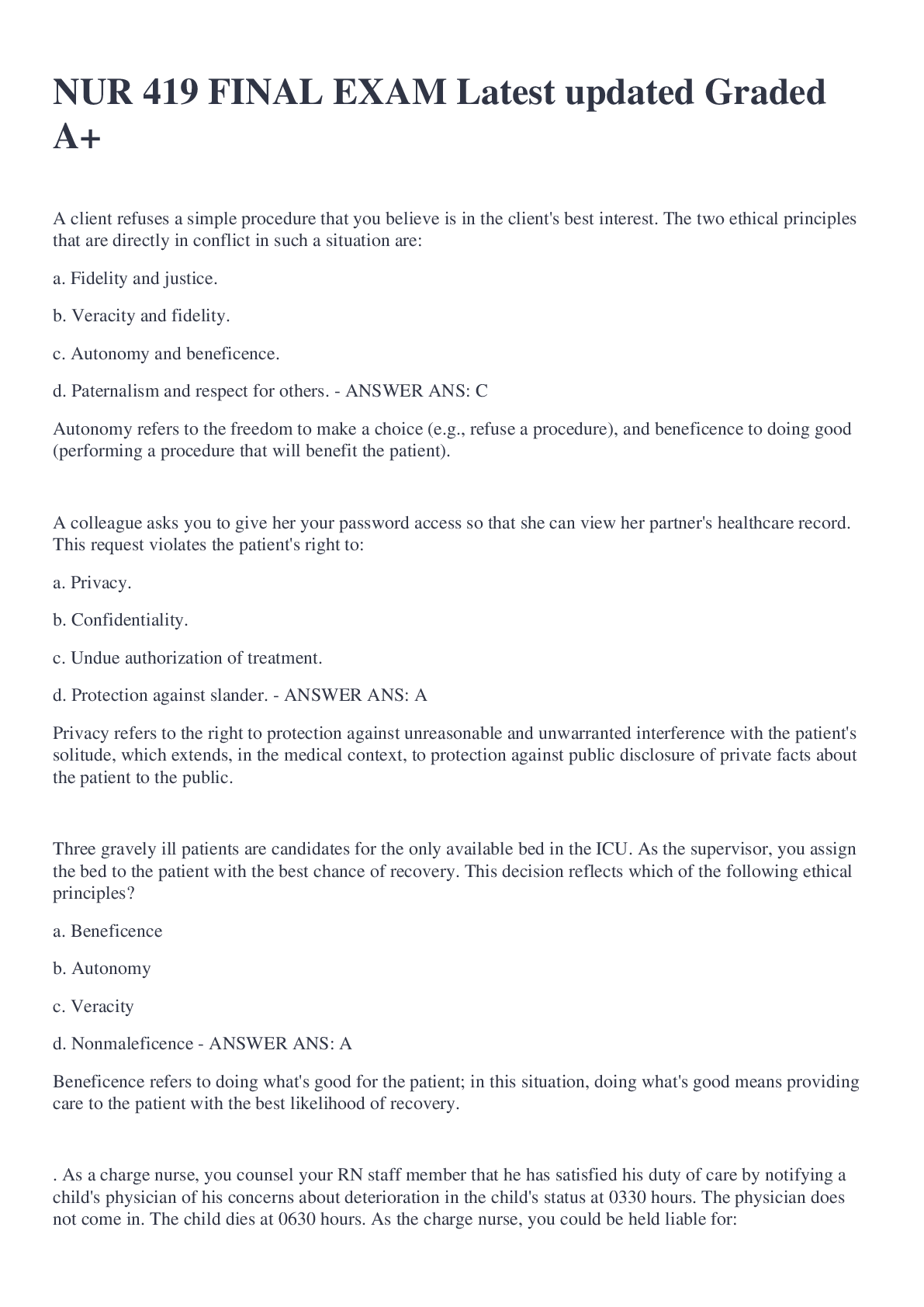
Reviews( 0 )
Document information
Connected school, study & course
About the document
Uploaded On
Sep 26, 2022
Number of pages
17
Written in
Additional information
This document has been written for:
Uploaded
Sep 26, 2022
Downloads
0
Views
38

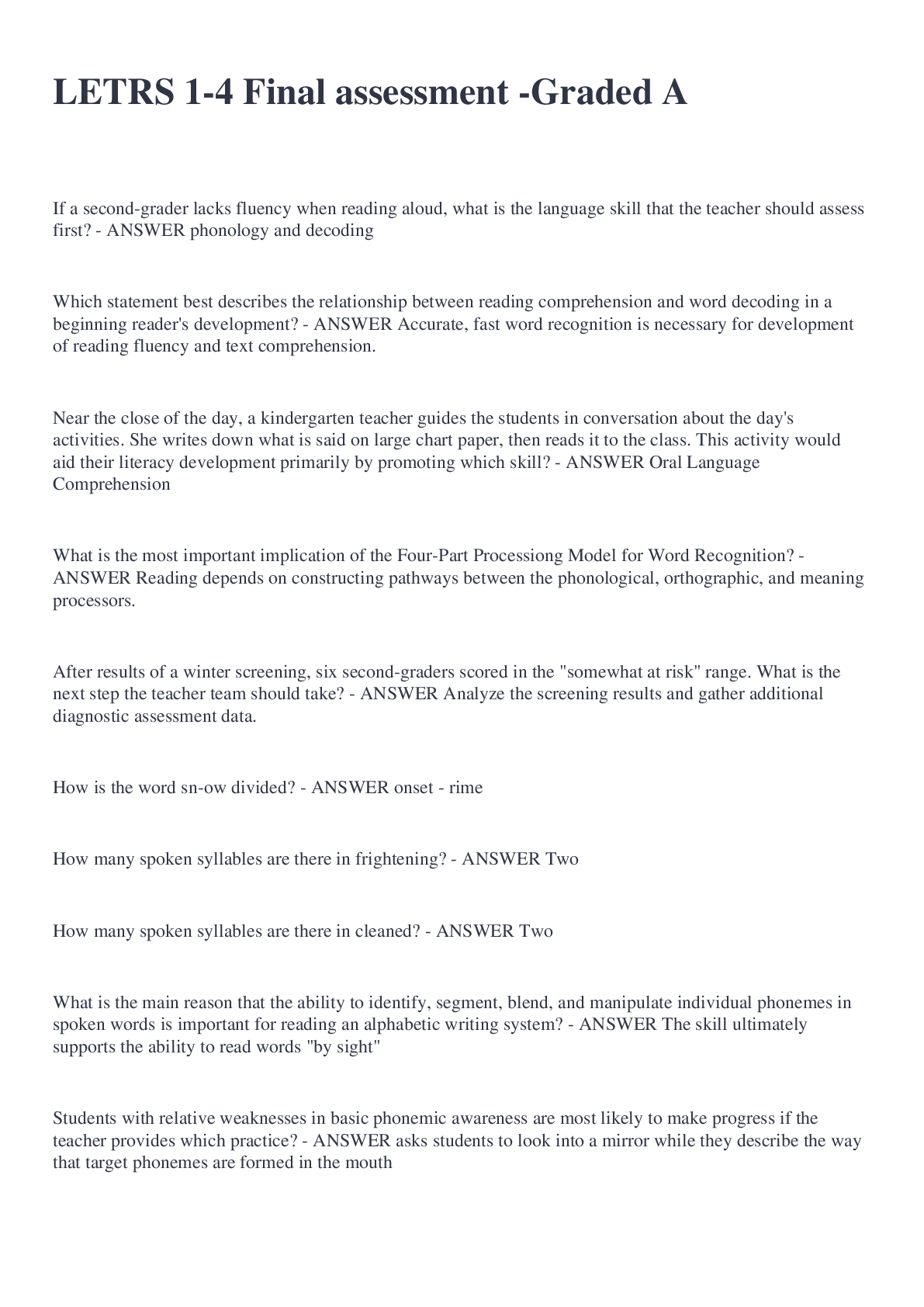


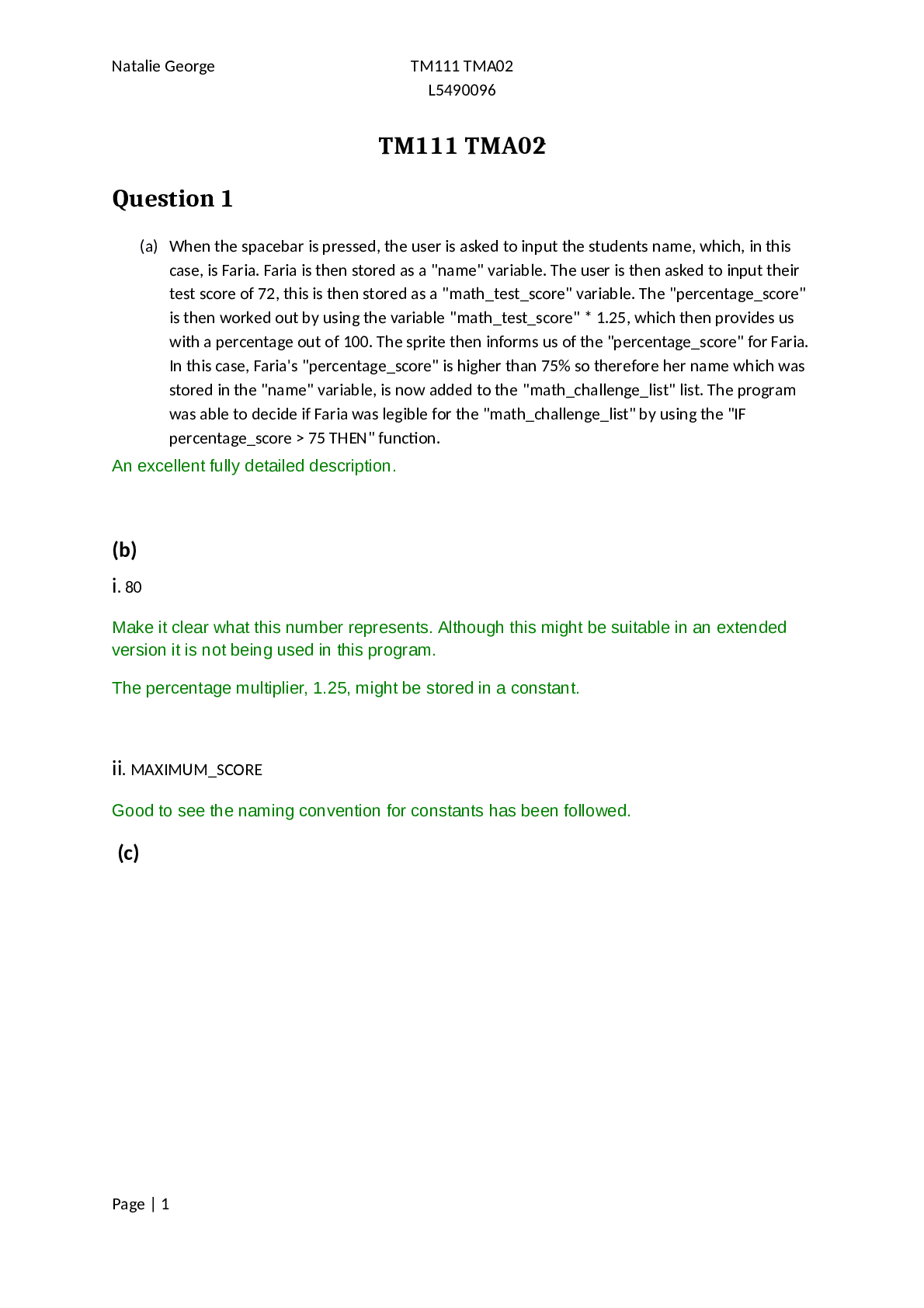


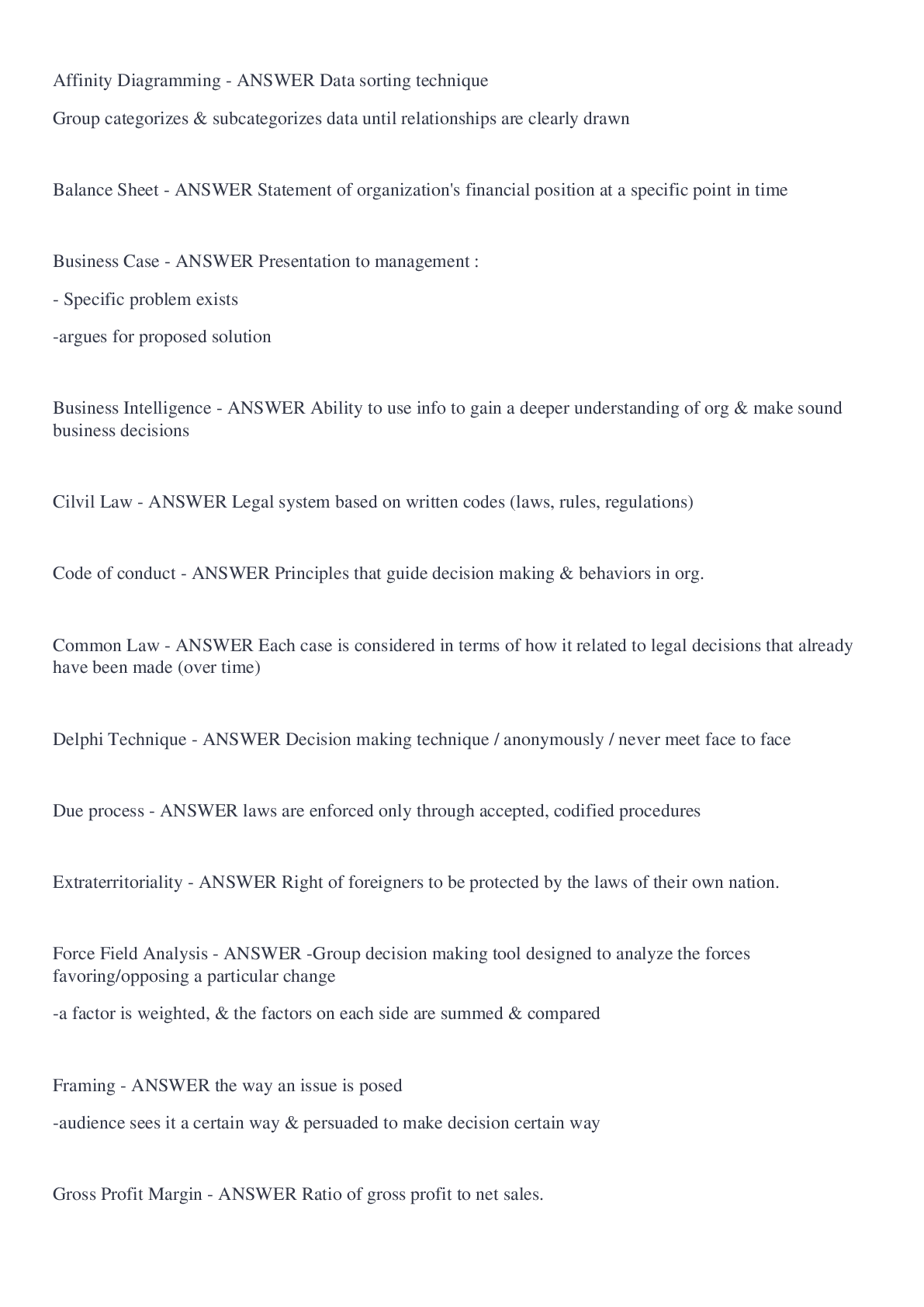

.png)
